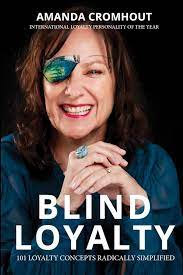Amanda Cromhout is an industry veteran who shares a career’s worth of insights and wisdom in her new book, Blind Loyalty. Presented as 101 loyalty concepts, it weaves in important strategies, age-old questions, instructive models and diagrams, and lots of inspiration with must-read quotes and industry examples!
The book is divided into 5 sections, covering why loyalty matters (Loyalty strategy and data), how to approach your loyalty strategy (Programme design and loyalty communications), who is doing what across different industries (Industry excellence), what the building blocks to build, manage and measure strong programs should be (Launching and managing a program), and finally, a concluding section on some of the higher order thinking around loyalty in terms of emotional loyalty, customer advocacy and an exploration of the psychology behind loyalty.
There is so much value in each page, but some ideas that stood out for me were:
- Loyalty marketing is more than the loyalty program: It is a combination of classic product marketing, service marketing as evidenced by people and processes, and finally 3 specific loyalty elements – the program, the personalization, and the philosophy.
- The case for customer-centric loyalty design: What decisions would you make differently if business performance was reviewed from a customer perspective rather than traditional product- or organizational-centric approaches? The book argues that most organizations are product-centric rather than customer-centric, which is why campaigns that drive product objectives (like new product launches or sales volumes) are focused on metrics such as unit sales instead of what customers want.
- Why all customers are not equal: One of the most powerful outcomes of customer insights is when executives realize they simply don’t have to treat all customers equally. Customers behave differently; they spend more or less at vastly different frequencies, resulting in different conclusions regarding customer value and profitability. Knowing which customers to target and what to offer them is the key to better ROI.
- The underrated key to minimizing customer promiscuity: The book challenges loyalty marketers to think about how they can help consumers maximize their rewards and benefits from loyalty programs. Bringing the ‘how to get the most out of your membership’ discussion front and center, it argues, will help drive engagement by allowing customers to make smarter choices about consolidating spending and maximizing rewards and benefits.
- The iceberg effect: Loyalty programs typically use ‘overt’ propositions (benefits available to all eligible participants) to attract new members to join the program and actively engage in data exchange. However, the real magic in terms of adding the most value to customers and creating positive behavioral change takes place when the ‘covert’ proposition (benefits not available to all enrolled members but personalized based on data gathered) is activated.
- Don’t forget your staff: Engaging frontline staff by educating and training them on the objectives of the loyalty program is an often-overlooked key to success, especially in a digital-first (But not digital-only) world. Customers can tell when frontline staff is not engaged with a loyalty program, and yet, so many loyalty programs are primed only for online execution.
- The power of rewarding non-transactional behavior: Rewarding non-transactional activities helps members feel valued, and is a powerful and meaningful way to keep members engaged beyond the traditional transaction. One of the main reasons people don’t use loyalty programs actively is that it takes too long to get to the rewards. Instead, ‘always-on’ rewards for non-transactional behavior reinforce brand values and can be very powerful. For example, a fitness brand can reward both – fitness product purchases and fitness behavior like showing up for events, sharing workout stats with the community, etc.
- Have you tried your redemption experience? The book firmly establishes that redemption is a good thing, providing data to put that debate to rest once and for all. It argues that customers change their behavior mainly after a redemption experience. For example, Qantas data shows that the greater the number of miles redeemed in a redemption transaction, the higher the likelihood of that member repeating flight bookings on Qantas. Unfortunately, many loyalty programs invest disproportionately in designing redemption offers, leaving the redemption experience itself full of friction.
The book balances strategic concepts with operational how-tos and real-life examples from brands you will recognize. And with 101 concepts wrapped into 200 odd pages, you are looking at bite-sized chapters that distill years of insights into just 2 to 3 pages. Don’t wait! Put it at the top of your 2024 reading shelf!
Get your copy of Blind Loyalty here.
Happy holidays everyone!


